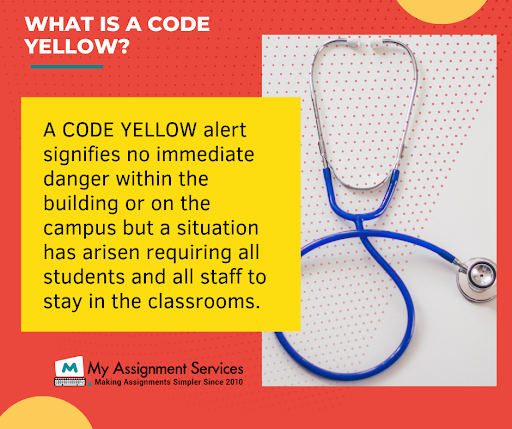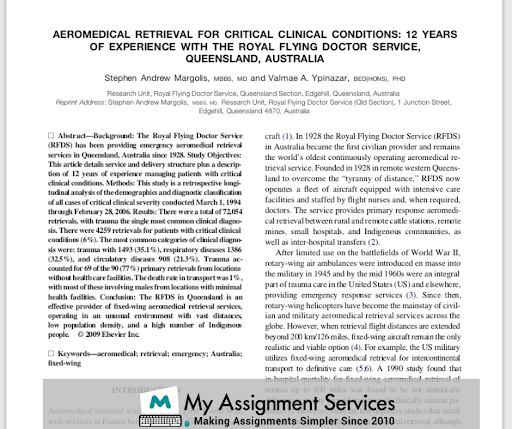As the Aeromedical Retrieval course equips medical practitioners to practise in the area with a broad body of knowledge in aeromedical transport, you as a student need to understand the core curriculum, which is built on a foundation of understanding of the clinical, operational, and organisational aspects of aeromedical transportation. However, the successful completion of assignments serves the purpose.
Those are designed for you for the improvement of skills. Some of you may find them confusing and problematic. But now, there are no problems anymore. My Assignment Services’ Aeromedical Retrieval Assignment Help sessions are here for you to focus on the operational and clinical aspects of an air ambulance, assessment, stabilisation, support medicine, and many more topics!
Retrieval medicine is all about clinically managing and safely transporting a patient from one site to another using appropriately skilled and trained personnel, transport platforms, and proper equipment! And our mentors of Aeromedical Retrieval Assignment Help online deal with primary, secondary, and tertiary retrievals, which are the three types.
Our 3000+ subject matter experts also engage in the custom sessions that find out problematic areas of your assignments, whether it is related to the conveyance of patients to their initial hospital reception or any other. Keep scrolling to know more!

Primary vs Secondary vs Tertiary Retrievals: Briefed By Our Aeromedical Retrieval Assignment Help Mentors
Primary retrieval could be the local hospital or a bigger, more distant facility, like an assigned trauma centre. Patients are sent from an institution, which has no specificities to an upper level of medical care, like neurosurgery, cardiology, difficult paediatrics or obstetrics, through secondary retrievals. Tertiary retrievals move patients among two equally specialised facilities.
In Modified primary retrievals, a wounded or ill patient is already transported to an initial health facility with limited capacity to give care beyond that given in the prehospital setting. In such cases, the team of retrieval follows the same procedures as in a genuine primary retrieval but in a more controlled setting.
Altitude And Aviation Explained In One of Our Aeromedical Retrieval Assignment Help Online Sessions
Even for healthy persons, air travel causes physiological changes and poses health hazards. Unwell patients are less tolerant of these changes, and the health risks connected with them are amplified.
In general, the cabins of helicopters used for aeromedical rescue are not pressurised, and they must fly below 10k feet above sea level. Fixed-wing aeroplane compartments are pressed up to 7000 to 8000 feet above sea level, similar to commercial airliners. At the level of the sea, the partial pressure of inspired oxygen is 149 mm Hg, but it reduces to 108 mm Hg over 8000 feet above sea level.
Online Assignment Help
Custom Essay Help
Dissertation Writing Guidance
This is equal to breathing 15% inspired oxygen at sea level. As a result, there is a lot of relative hypoxia (because of altitude or insufficient aircraft pressurisation). Side effects consist of myocardial syncope, ischaemia, loss of consciousness, and decreased mental performance. Supplemental oxygen may be required throughout the flight if the aircraft is not pressurised to sea level cabin height.
Moreover, our Aeromedical Retrieval Assignment Help mentors explains that long periods of immobility raise the thromboembolic events are a possibility. Temperature, noise, and vibration stress can all have an adverse effect on the stability of the patient and make health personnel's jobs more difficult.
Prophylaxis should be considered routinely since motion sickness may have serious consequences for both the obtunded or ill patient and the retrieval crew. Two difficulties that may need to be handled before a patient is loaded onto a plane are fear of flying and fear of heights.
Aside from variations in partial gas pressures as altitude rises, a special understanding of and accounting for modifications in atmospheric pressure is needed.
The physical effects of decreased barometric pressure on the body include the expansion of gas-filled cavities like the eardrum, gastrointestinal system, sinuses, lungs, and potential spaces, including the pleural space. If the patient's medical condition requires it, the cabin can be pressurised at or near sea level, or the flying altitude may be decreased to enhance the barometric pressure.
This is required in cases of severe hypoxia, intestinal sickness, significant undifferentiated trauma, and diving specific disorders. When pressed to the cabin altitude at sea level, aircraft are unable to go their altitudes of normal cruising. They carry more fly lower, fuel, and slower, reducing their range of flying and potentially exposing them to maximised turbulence and bad weather.
Aeromedical Retrieval Assignment Samples


Stabilisation And Assessment: Important Points To Remember
Prior to patient movement, methodical analysis of the breathing, airway, neurology, circulation, and other important aspects is performed. This is best done at the hospital of reference or patient location, albeit this may cause considerable delays as the retrieval team is moved among retrieval aircraft and the patient's location or referral hospital. Correspondingly, the referral team may transport the patient to the point of departure. Pragmatism may require a targeted primary survey prior to initial transfer and an extra extensive analysis at the receiving hospital or prior to a longer flight.
'Stay and Play' vs 'Scoop and Run' has been a point of contention for a long time among retrieval medicine professionals and services worldwide. In other words, some patients will gain the better from a quick analysis or assessment, modest stabilisation, and swift up-gradation to definitive care. Others may deteriorate severely upon way if the recovery crew does not begin further stabilisation before transfer. The choice of which of these principles is best in a specific situation is difficult, as it depends not only on the patient and disease, but also on local competence, logistics, transport team skill, and period to definitive care.
Many providers of inexpensive or cheap assignment help in Australia say that it's critical to start reliable monitoring during this period of assessment and stabilisation. This could be anything from invasive monitoring to oxygen saturation investigation, including the incorporation of arterial catheters and central venous. With the perplexing dangers of air travel, practitioners should consider both the risk of worsening in the air and the restricted ability to accelerate treatment while in flight while balancing this with the necessity for prompt conveyance. Although cannulation of a patient at an airport may not be ideal, it is more likely to be prominent than trying to do it on a fast failing patient wearing seatbelts at altitude in turbulence.
The time when a patient is transferred from the hospital to the aircraft is one of the most dangerous occasions for them. This becomes more complicated when further transfers are required, such as when the patient requires ambulance transportation to and from the aeroplane. As the number of individual patients moves grows, so does the risk. There are risks to workers in addition to the potential for tube separation and dislodgement. Patients who are obese or inebriated and those who are exposed to extremes of weather, poor visibility, and hazardous surroundings all pose challenges to successful prehospital care.
If you want to understand these points better or want to know, even more, avail of our Aeromedical Retrieval Assignment Help now!
24 X 7 Support
100+ Subjects Covered
2000+ Ph.D Experts
FAQs Answered By Our Aeromedical Retrieval Assignment Help Mentors
Q1. Do Nasa Flight Surgeons Go to Space?
Every crew preparing for a space mission is assigned a flight surgeon by the National Aeronautics and Space Administration (NASA). Before, during, and after spaceflight, these doctors are in charge of the astronauts' health care, medical examinations, and training.
Q2. How Does the RFDS Work?
The RFDS assists rural Australians in a variety of ways. The RFDS gives 24-hour aeromedical emergency services that can go anywhere, no matter how remote, within a few hours, because of the waiting room of 7.69 million square kilometres.
Choose Us For The Best Aeromedical Retrieval Assignment Help Online
You can contact our professionals for inexpensive or cheap assignment help in Australia at any time to solve all of your assignments issues and sit back and relax in sessions. The end outcome will be flawless. You should use us for the following reasons:
- Extra sessions for an explanation of academic writing guidelines as per your assignments. It may be APA, MLA, Chicago, Harvard, and others.
- Access to 1+ million resources
- We prioritise writing tips and guide you to the common mistakes you have made.
- We will help you make an impressive track record.
- Great customer service 24x7.
- Live chat with the expert.
So hurry up! Get in touch with us.
Get It Done! Today
1,212,718Orders
4.9/5Rating
5,063Experts
Highlights
- 21 Step Quality Check
- 2000+ Ph.D Experts
- Live Expert Sessions
- Dedicated App
- Earn while you Learn with us
- Confidentiality Agreement
- Money Back Guarantee
- Customer Feedback
Just Pay for your Assignment
Turnitin Report
$10.00Proofreading and Editing
$9.00Per PageConsultation with Expert
$35.00Per HourLive Session 1-on-1
$40.00Per 30 min.Quality Check
$25.00Total
Free- Let's Start







